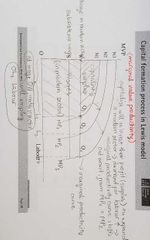![]()
![]()
![]()
Use LEFT and RIGHT arrow keys to navigate between flashcards;
Use UP and DOWN arrow keys to flip the card;
H to show hint;
A reads text to speech;
18 Cards in this Set
- Front
- Back
|
3 sustainable development goals |
-no poverty -zero hunger -gender equality |
|
|
Describle characteristics of private vs common property resources |
-private property: excludable + rivalry •exp: cloths, car -common property resources: non-excludable + rivalry •exp: pasture, fish |
|
|
What is problem of common property resources? |
-When a good is rivalry but non-excludable => overuse to the detriment of all. -> The free rider problem with common resources: common resources tent to be used excessively when individuals are not charged for their usage. =>Tragedy of the commons -exp: pasture degradation (due to overstocking), overfishing.
|
|
|
Name 3 rules of an efficient system of property rights |
1. Universality 2. Excludesiveness 3. Transferability |
|
|
Public property & open access property describle almost same thing? |
No - Public property is owned by state - open access property does not belong to anyone, everyone can have access. |
|
|
3 causes of pollution |
1. Air pollution -burning of fuel, coal, wood 2. Water pollution -industrial wastes in rivers -oil spills in oceans -textile chemical prodution (jeans) 3. Soil/land pollution -minning -industrial wastes -deforestation |
|
|
3 Effects of pollution on human health |
- air pollution: asthma, lung cancer - water pollution: skin irritations, diarrhea. - noise pollution: stress, sleeping disturbance, hearing loss |
|
|
-3 measures to prevent pollution -3 measures to preserve natural resources |
1. Taxes (pigou tax) (property tax) 2. Regulations/standards 3. Labeling/certification |
|
|
How taxes work? Advantage & disadvantage of taxes. |
- Basic principle: tax eliminates the divergence between marginal private cost (MPC) & marginal social cost (MSC) - Advantage: does not require negotiation between parties. - Disadvantage: may be difficult to find the right tax level. |
|
|
Problems & requirements of Regulations |
-regulator needs a lot of info -restrictions may be too harsh or too loose. -it requires laws (legislative), enforcement (executive) and court system (judicative) to implement.
|
|
|
3 major assumptions of Lewis Model |

*There are 2 sectors in economy of a developing country: 1.capitalist sector (manufacturing sector) 2.subsistence sector (agricultural sector) -> capital sector has higher productivity than subsistence sector. *Unlimited supply of labour *Modern sector reinvests their profits and that constitute the main source of capital formation. |
|
|
1.What is vulnerability? 2.Vulnerability as expected poverty? 3.Examples of shocks |
1.-Vulnerability = risk –the ability to cope -Vulnerability is the probability now of not having enough something valuable in the future, i.e. the probability NOW of a shortfall in FUTURE. 2.-Indicator of well-being: Consumption, income -Threshold for consumption: Poverty line →Vulnerable: Whose probability of shortfall exceeds the threshold 3. exp:Illness, Disability,Marriage Divorce Migration, discrimination, disease |
|
|
Why is there still poverty in developing country despite economic growth?
|
-Economic growth does not automatically result in poverty reduction. -Economic growth can lead to inequality. -Cheap labour is an essential ingredient to economic growth |
|
|
3 Indicators that characterize poor country
|
|
|
|
1.What is poverty 2. What is poverty measurement? 3.Why need to measure? 4.Poverty analysis -Which dimension to choose? |
1.-deprivation in well-being -Those who are poor do not have enough income 2.Head Count Ratio 3.•Compare poverty over time and countries. •Assess effects of projects, policies, etc. •Target poor groups to improve their position. 4.-Welfaristapproach (economical) -Non-welfaristapproach (socio-cultural ): Functionings,Basic needs, Capabilities
|
|
|
Problems of the welfarist approach
|
1.( Uni-dimensional and quantitative) -Need to measure levels of utility or"psychic happiness -Some dimensions of well-being (participation, empowerment) cannot be captured by income or consumption =>Money-metric indicators remain imperfect indicators of well-being. 2. (Multidimensional and qualitative) -How to measure a functioning like “self-respect”? •Capabilities are not observed directly=> measurement difficulties |
|
|
1.common indicators to measure poverty. Why? ->2. The Foster-Greer-Thorbecke(FGT) poverty indicators |
1.-Income or consumption, though they imperfect ->Simple identification of the poor Clear analysis and comparison of poverty 2. |
|
|
|
|

